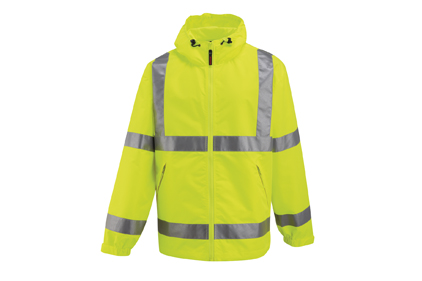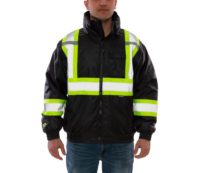Night and day: Select hi-vis apparel for 24/7 visibility

What’s hi vis?
The combination of fluorescent background color and reflective materials is specifically designed to produce a high level of visibility in light or dark environments.
Daytime: The base fluorescent material increases visibility during daylight. Fluorescents are different from ordinary colors in how they absorb and convert light energy, including ultraviolet waves. Fluorescent colors absorb energy from lower wavelengths and then re-emit energy, so they appear to glow. A clean, conventional color can reflect a maximum of 90 percent of a color present in the spectrum; a fluorescent color can reflect as much as 200 to 300 percent, so you see a far more intense color.
Nighttime: At night, reflective tape increases visibility. As light from car headlights hits the tape, the light is reflected back to the driver.
Fluorescent materials and reflective materials are combined in certain ratios and designs to make a garment that is compliant with ANSI regulations for hi-vis apparel and visible from more than 1,000 feet away, day or night.
ANSI/ISEA regulations
Today, we’re thankful for these technologies and ANSI regulations because they help protect workers. Road workers face potentially dangerous environments of motorists and fast moving vehicles every day. According to the Federal Highway Administration (FHWA), one work zone fatality occurs every 10 hours (2.3 per day), and one work zone injury occurs every 13 minutes (110 per day). Increased awareness and visibility in work zones helps protect the safety of everyone on the road, and this is exactly the purpose of hi-vis apparel.
The first U.S. standard for the design and performance of materials for high-visibility apparel was ANSI/ISEA 107-1999, and since then revisions have been made to enhance the materials and design, material performance, labeling and overall effectiveness of high-vis-apparel.
Most recently ANSI/ISEA 107-2010 has updated guidelines regarding high-visibility garments worn by road workers specifying component materials performance, overall design, colors and placement of reflective material, labeling and testing, among others. These new guidelines are now used in the product design process to develop garments for each class requirement, and thorough testing is done to ensure products meet the class requirements.
Choosing the right apparel
If your work environment requires or could benefit from hi-vis apparel, these easy steps help ensure your safety as well as the safety compliance of your employees.
1) Review copies of the regulations. Read through ANSI/ISEA 107-2010 to ensure all standard and relevant regulations are considered.
2) As cited in the 2009 MUTCD Section 6D.03, survey the worksite hazards to determine the appropriate class of garments needed. Class 3 garments must meet additional guidelines and offer the highest level of visibility. Certain positions, like roadway construction workers where road speeds exceed 50 mph, will automatically require Class 3 garments. The survey should take into consideration how close workers will be to the traffic, common weather conditions, speed of the traffic, other colors on the site, etc.
3) Select the appropriate garment for the job. In addition to determining which class garment is needed, it’s important to consider function, comfort and durability. Manufacturers offer a wide array of hi-vis apparel to accommodate a variety of work environments and temperatures, from Class 2 lightweight t-shirts and sport-mesh vests, to Class 3 full-body waterproof rain suits and wind-blocking hooded sweatshirts. It’s important that the hi-vis clothing is comfortable and allows for normal movement.
4) Review the choice with a visibility demonstration or a wear test to ensure the best class and style garments have been selected.
5) Publish specific guidelines and require that only certified products be used.
6) Whenever safety apparel is issued, provide training that explains the purpose of high-visibility garments and how to care for them. The better each individual understands the importance of hi-vis garments and how to care for them, the more effectively the apparel can be used.
The useful life of a hi-vis garment will vary with the work environment, but with everyday use hi-vis apparel should be replaced every six months or as soon as it reaches its maximum number of washes as indicated on the label. Some conditions, such as high elevations, hot climates and dirty or dusty work conditions, will decrease the effectiveness of the clothing more quickly.
Resources
American Traffic Safety Services Association
Federal Highway Administration
International Safety Equipment Association
The New York Times
Looking for a reprint of this article?
From high-res PDFs to custom plaques, order your copy today!




